Ustad Asad Ali Khan | Rudraveena
Asad Ali Khan was an Indian musician who played the plucked string instrument rudra veena. Khan performed in the style dhrupad and was described as the best living rudra veena player in India by The Hindu. He was awarded the Indian civilian honor Padma Bhushan in 2008. Khan was born 1937 in Alwar in the seventh generation of rudra veena players in his family. Khan was one of a few active musicians who played the rudra veena and the last surviving master of one of the four schools of dhrupad, the Khandar school. Khan received several national awards, including the Sangeet Natak Akademi Award in 1977 and the civilian honor Padma Bhushan in 2008, which was awarded by Indian President Pratibha Patil. He was described as the best living rudra veena player in India by The Hindu and lived in Delhi Details of the video: ARDG DVC 60 5070
Playlist
Category
- Dhrupad
Dhrupad is a genre in Hindustani classical music from the Indian subcontinent. It is the oldest known style of major vocal styles associated with Hindustani classical music, Haveli Sangeet of Pushtimarg Sampraday and also related to the South Indian Carnatic tradition. It is a term of Sanskrit origin, derived from dhruva (ध्रुव, immovable, permanent) and pada (पद, verse). The roots of Dhrupad are ancient. It is discussed in the Hindu Sanskrit text Natyashastra (~200 BCE – 200 CE),[3][4] and other ancient and medieval Sanskrit texts, such as chapter 33 of Book 10 in the Bhagavata Purana (~800–1000 CE), where the theories of music and devotional songs for Krishna are summarized
Musical instrument
रुद्र वीणा
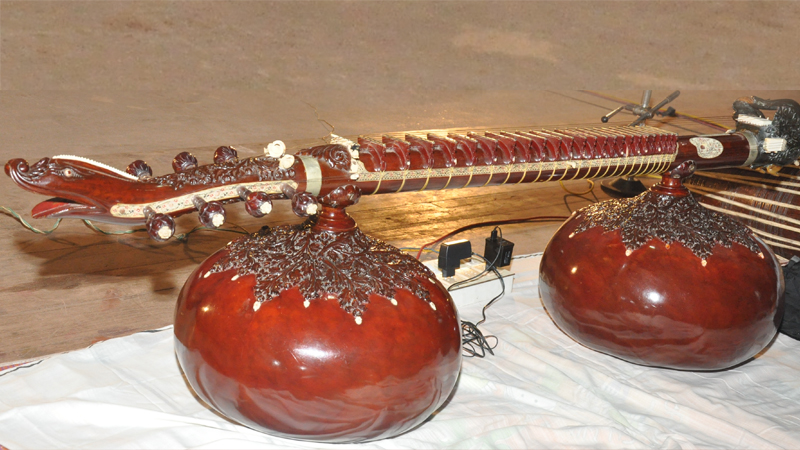
रुद्र वीणा एक प्राचीन वाद्य यंत्र है। इसमें सागौन की लकड़ी या बाँस से बना एक लंबा नलीदार ढाँचा होता है, जिसके दोनों किनारों पर लगभग चौदह इंच के दो खोखले अनुनादक/तुंबे लगे होते हैं। यह तुंबे सूखे या खोखले कद्दू से बने होते हैं। इसमें अंगुलिपटल (दाँडी) पर पीतल की चौबीस सारिकाएँ (मंद्र, मद्ध्य, और तर: तीनों सप्तकों में) लगाई गई होती हैं, जिन्हें मोम की मदद से अचल बनाया जाता है। इन सारिकाओं के ऊपर पीतल की पतली नुकीली प्लेट्स लगाई जाती हैं, जिन्हें सार कहा जाता है।
इसमें 4 मुख्य तार और 3 चिकारी/ताल (दो दाईं ओर और एक बाईं ओर) तार होते हैं। ये सभी तार 3 कीलों, जिन्हें ककुभा कहा जाता है, की मदद से नली के एक कोने पर बांधे जाते हैं, जिसमें तारों को समायोजित करने के लिए दोनों तरफ 8 नियामक होते हैं। चार मुख्य तार मुख्य घुड़च से गुजरते हैं और अपने संबंधित खूँटियों में बंधने से पहले, वे मेरु कहे जाने वाले एक ऊपरी घुड़च से होकर गुजरते हैं। चिकारी तार अपनी-अपन खूँटियों पर लगने के लिए दो पार्श्व घुड़च पर लगे होते हैं, एक-एक दोनों तरफ। इसमें लगभग साढ़े तीन फ़ीट की लंबाई वाला एक अंगुलिपटल (दाँडी) होता है जो सभी सारिकाओं और तारों को एक साथ रखता है। यह दाहिने हाथ की तर्जनी और मध्यमा अंगुली में पहने जाने वाले मिजराव से बजाया जाता है। पार्श्व तारों को छोटी उंगली पर पहने गए मिजराव से बजाया जाता है। ड्रोन तारों के बाएँ पार्श्व को छोटी उंगली पर पहने गए मिजराव से बजाया जाता है। रुद्र वीणा को बजाने का पारंपरिक आसन वज्रासन या दरबारी बैठक हुआ करता था (जिसमें वीणा को तिरछे रखा जाता था, जहाँ ऊपरी तुंबा बाएँ कंधे पर टिका होता है, जबकि निचला तुंबा दाहिनी जांघ पर रखा जाता है और अंगुलिपटल (दाँडी) छाती के पास रखा जाता है)। बाद में, वादकों ने इसे बजाने के लिए एक नई मुद्रा का आविष्कार किया, जिसे सुखासन के रूप में जाना जाता है (इसमें वीणा को आधा तिरछा रखा जाता है, ऊपरी तुंबे को दाहिनी जांघ पर रखा जाता है, जबकि निचले तुंबे को फर्श पर रखा जाता है और अंगुलिपटल (दाँडी) को छाती से दूर रखा जाता है। पारंपरिक मुद्रा में रुद्र वीणा बजाते समय जिन कठिनाइयों का सामना करना पड़ता था, इस नई मुद्रा से उन परेशानियों में कमी आई। माना जाता है कि वीणा शब्द का उद्गम वण शब्द से हुआ है, और यह ऋग्वेद में वर्णित एक तार वाद्य यंत्र है। वैदिक पुजारी कात्यायन ने अथर्व वेद में सौ तारों से युक्त एक वाद्य यंत्र के बारे में बताने के लिए भी वण का प्रयोग किया। वण का अर्थ ध्वनि (शब्द) और गति उत्पन्न करना है। इसलिए, वण को वह तार वाद्य यंत्र माना जाता था जिसने वीणा को जन्म दिया। यह माना जाता है कि रुद्र वीणा भगवान शिव द्वारा देवी पार्वती की सुंदरता के लिए एक श्रद्धांजलि के रूप में बनाई गई थी। माना जाता है कि इस वाद्य यंत्र को भगवान शिव ने सबसे पहले बजाया था, और यह भी माना जाता है कि इसमें आध्यात्मिक शक्तियाँ होती हैं। यह माना जाता था कि रुद्र वीणा महिलाओं के नाजुक कंधों के लिए बहुत भारी हुआ करता था। लिहाजा, महिलाओं को इसे बजाने की अनुमति नहीं थी। हालांकि, आधुनिक युग कुछ महिला वादक भी हैं।
रुद्र वीणा अब लगभग विलुप्ति के कगार पर पहुँच चुका एक दुर्लभ वाद्य यंत्र बन गया है। इसको बनाने वाले शिल्पकार और साथ ही इसके वादक, दोनों ही, अब बहुत कम पाए जाते हैं। इस वाद्य यंत्र ने उन्नीसवीं सदी के शुरुआती दिनों में सुरबहार, सितार और सरोद, आदि जैसे अन्य तार वाद्य यंत्रों के विकास के साथ ही अपना महत्व खो दिया। यह लकड़ी से बना एक लंबा नलीदार ढाँचा। इसमें दो बड़े आकार के गोल अनुनादक होते हैं, जो केंद्र से एक समान दूरी पर, नली के नीचे लगे होते हैं और उत्तम गुणवत्ता वाले कद्दू से बने होते हैं। इसमें चार बजने वाले तार लगे होते हैं, जिनमें से एक इस्पात और तीन तांबे के तार होते हैं जो निचले छोर पर हुक से बंधे, और नली के समानांतर खिंचे होते हैं और अलंकृत समस्वरण खूँटी तक ले जाए जाते हैं। नली के दोनों तरफ घुड़चों पर दो ड्रोन तार होते हैं जो अपनी-अपनी खूँटियों तक खिंचे होते और उससे बंधे होते हैं। चौबीस पीतल युक्त उभरे हुए लकड़ी की सारिकाएँ होती हैं जिन्हें मोम की मदद से नली पर लगाया गया होता है। इसमें लगे अनुनादक बड़े पैमाने पर लकड़ी के फूलों की नक्काशी से सजाए गए होते हैं। इसमें खूँटी धानी पर भी नक्काशी हुई होती है। नली का निचला सिरा एक पक्षी की उकेरा जाता है और हाथी के दांत से बने चौड़े समतल घुड़च के लिए आधार के रूप में कार्य करता है। बजाते समय, एक तुंबा बाएं कंधे पर और दूसरा तुंबा दाहिनी जांघ पर टिका होता है। इसे दाहिने हाथ की उंगलियों पर पहने जाने वाले तार से बने मिजराव के द्वारा बजाया जाता है। यह उत्तरी भारतीय शास्त्रीय संगीत में उपयोग होने वाला वाद्य यंत्र है।”
वर्गीकरण
Comments
Trance Dhrupad | Ustad Bahauddin Dagar
Trance Dhrupad | Ustad Bahauddin Dagar | Raag Kausi Kanada | Music of India
he Ustad brought his rudra veena’s low tones to London for a rare unaccompanied concert in 2019, superbly presenting undiluted Dagarvani Dhrupad- Log in to post comments
Tags
- Log in to post comments
- 559 views
- 55 views

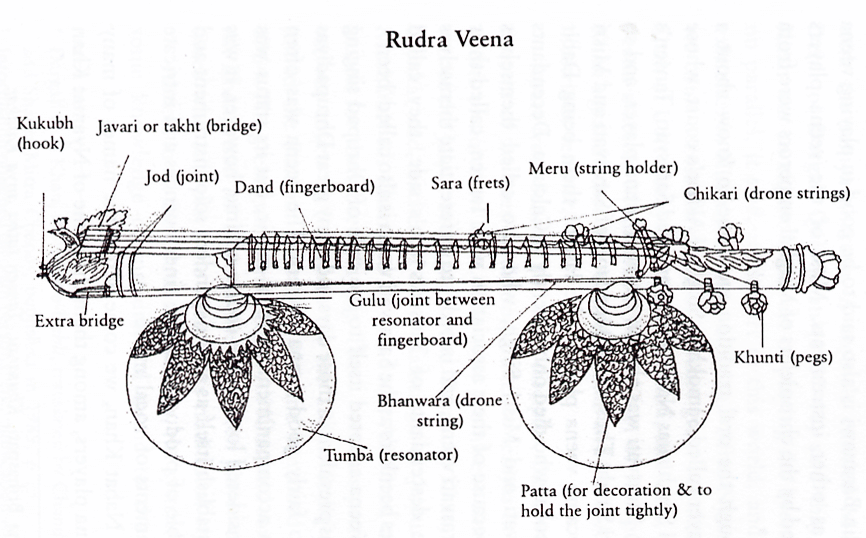

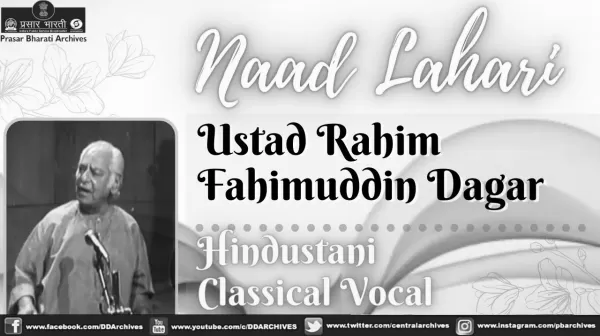
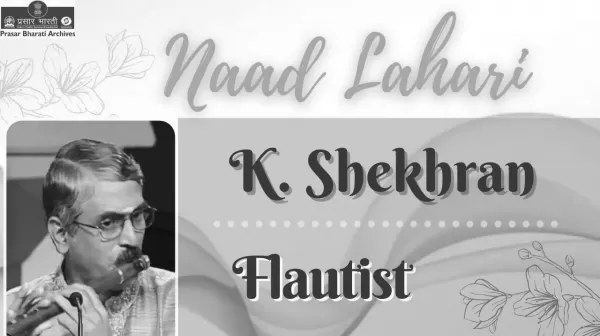
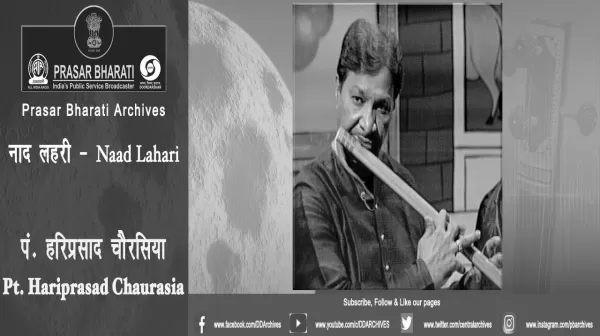

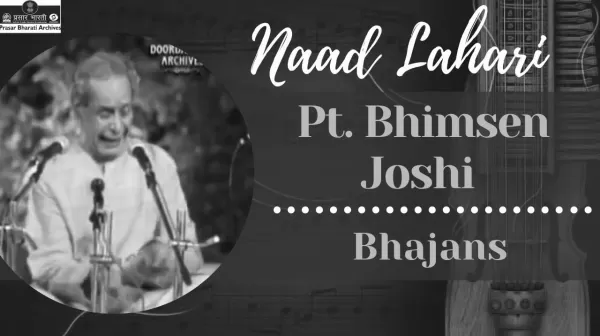

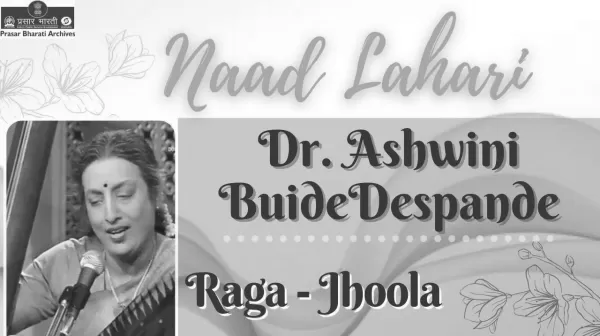
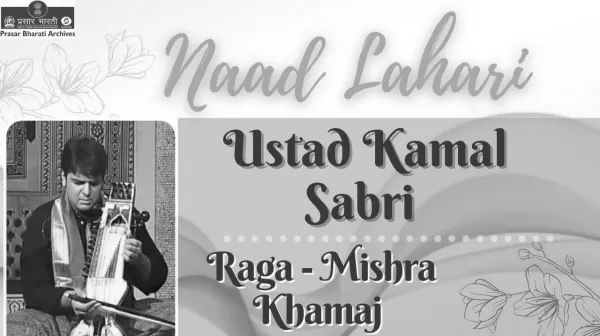
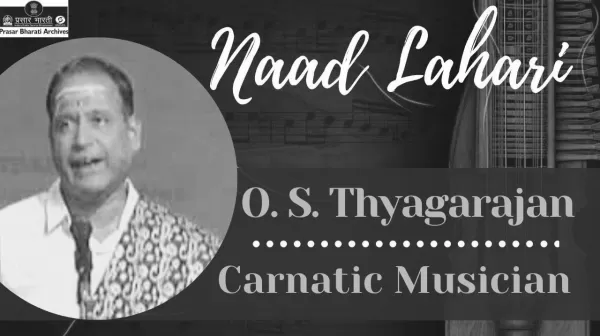
RUDRA VINA
In the hierarchy of divinities, the veena enjoys a special place. It is the instrument which symbolises the Indian ethos throughout the country. The instrument has sociological and cultural connotations and dimensions. Saraswati, the goddess of learning is visualised as holding a veena in her hands and is always called Veenapani or Veenapustaka Dharini.
In ancient India the term veena was used in a generic sense, intended to refer to any stringed instrument — monochord, polychord, bowed, plucked, fretted, non-fretted, zither, lute or lyre. Scholars are of the opinion that the word veena might have been derived from its forerunner vana, a string instrument mentioned in the Rig Veda, and later in the Atharva Veda, Katyayana used the word vana with hundred strings. Vana means to sound. The term vana has been derived from the root van which means sound (shabda) or speed (gati). The root van conveys the idea of both sound (shabda) and tone (swara), and so does the term veena. From the references it can be concluded that vana was the most ancient type of stringed instrument and that different kinds of stringed instruments were designed after it.
Scholars are unanimous that till the sixth century the string instruments that we get were not fretted.
Rudra Vina in our catalogue
The veena is played with two plectrums worn in the index and middle fingers of the right hand, while the side drone strings are flicked with the help of the small finger's nail. However, some artists wear plectrum in the small finger as well. The drone string of left side is flicked with the left hand little finger's nail. The traditional sitting posture of veena playing, called vajrasan or darbari baithak, is quite difficult. Zia Mohiuddin Dagar used to sit in sukhasan instead. He also kept his veena half diagonally like the Southern veena whereas traditionally the rudra veena is placed diagonally and the upper gourd rests upon the left shoulder while the lower gourd rests upon the right thigh of the player. The fingerboard is held close to the chest.
The veena consists of a fingerboard, the length of which is about three-and-a-half feet, and two broad gourds of about fourteen inches in diameter fixed in the stem. Previously the stem or the fingerboard was made of bamboo. This bamboo had a very short span of life and every alternate year it had to be changed. Lately, bamboo has been replaced by teak wood, which gives a longer life and better tone to the veena.
According to Asad Ali Khan, this change occurred in the early twentieth century, as his father Sadiq Ali used to have a veena of teak wood fingerboard instead of bamboo.
Twenty-two wooden frets are fixed on the fingerboard and are made immovable with the help of a specially prepared wax- like liquid. Thin sharp-edged plates of brass are fixed on top of these frets called sara. However, the number of frets are not fixed and tend to vary according to the artist's preference. The veena has seven strings in all — four main playing strings and three drone strings, two on the right side and one on the left. All of these strings are tied with three nails called kakubha on one corner of the dand. Four of the main playing strings pass through the main bridge and before being finally tied up into the respective pegs, they pass through an upper bridge called meru. The three drone strings,-two on the right and one on the left, are mounted upon two side bridges, one at either side, and meet their respective pegs.
Veena is a rare instrument almost on the verge of extinction. It is not easy to get a new veena made, because there are also very few craftsmen left who are working on this rare instrument.
https://www.india-instruments.com/encyclopedia-rudra-vina.html